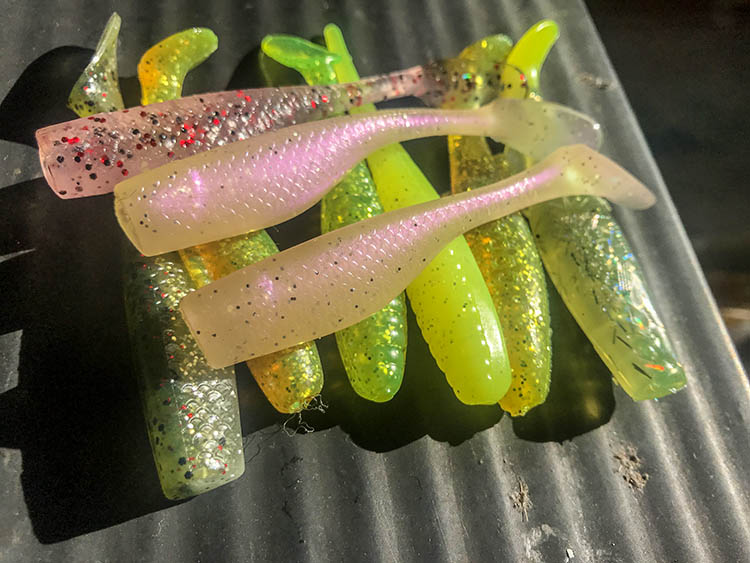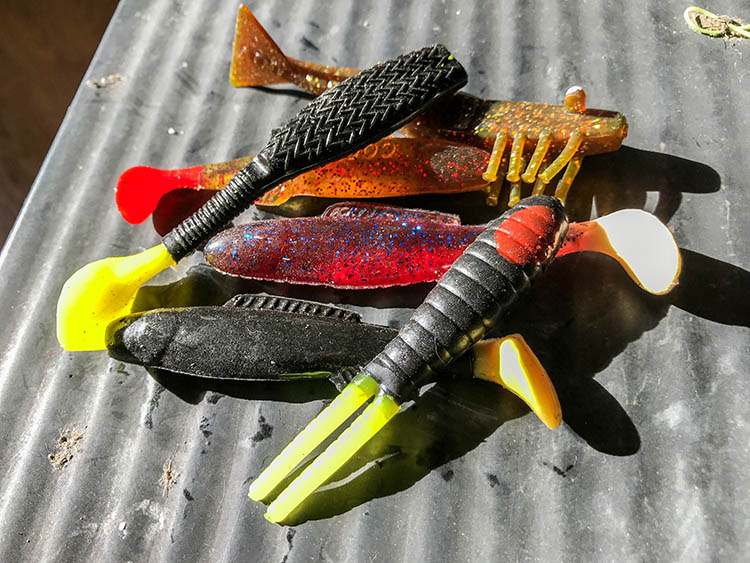These are the kinds of lure colors I use to catch speckled trout, and why I use them.
I'm sure you've heard the old adage:
Lures catch more fishermen than they do fish.
It simply portrays the idea that anglers spend more time fawning over lures at the tackle store than fish do when the lure is in the water.
One of the things anglers fawn over, and sometimes bicker about, is lure color.
But is lure color that important?
If you're not catching fish at one spot, do you keep changing colors?
Soft Plastic Colors For Speckled Trout
Used to, you could look at my tackle box and see a rainbow of lure colors.
Today I keep things a little simpler, and leave the variety at home.
Can speckled trout and redfish see color?
Yes.
Marine biologists a lot smarter than me have already done the research, going so far as to capture speckled trout, sedate them and put them into a sling inside a blacked-out enclosure in order to test their eye vision.
Without delving into the long-winded science, trout can see color fairly well and redfish possibly see color even better.
But, despite this information, I still use a fairly small selection of lure colors.
Two Lure Colors
I keep a light and dark color handy.
A light color is typically chartreuse, or white, or Matrix Shad's "Ultraviolet".
A dark color would be a purple, or even black.
It's pretty simple, and I'm satisfied fishing with any of these colors.
Why do I carry two kinds of colors for speckled trout?
Well, the speckled trout I'm chasing don't experience a lot of angling pressure.
They're more ready to eat, and make more mistakes, than a 5lb bass living in a tournament-ridden lake.
When they first detect my soft plastic, they go straight for the kill, scrutinizing by taste rather than sight.
By then, it's too late and they're hooked.
But, there is more reasoning behind why I carry two kinds of colors for speckled trout.
Let me explain.
Light Lure Colors

I use these colors to catch speckled trout when the water is clean.
Chartreuse is the "go-to" for "trout green" water.
What is 'trout green' water?
"Trout green" is a term used to describe salty, clean and green water.
It's "clean" if you can see your lure a few feet below the surface.
I use these colors for the best reason ever: I've caught fish on them.
A lot of fish.
But also because science backs the fact that speckled trout can see that color in the light spectrum.
And because they can see and discern color, chartreuse is a bright "look at me" color that strongly contrasts with the background.
With that said, I may try another light color if experimentation proves it catches more fish.
Dark Lure Colors

I'll try dark lure colors when I am fishing dirtier water.
Less light penetrates dirty water, making it difficult for trout to discern color.
A darker color offers a more visible profile.
This is a harder, more-defined outline of the lure shape to catch the trout's attention.
How often should I change colors?
Not often.
I don't change colors much. I'll switch from light to dark, or vice versa, if I don't get any bites.
Assuming I have effectively fished the entire water column, and the Big Three are present at that location, I'll then pick up and move to my next spot.
What's far more important than lure color is presentation.
You can change lure colors until you're blue in the face, it won't matter if the trout never sees it.
Conclusion
Making different lure colors is how companies keep anglers coming back for more.
And, most speckled trout are not pressured to the point they closely scrutinize lures.
Because of this, I focus less on lure color and more on lure presentation.
This way I can cover more water and catch more fish, in less time.
Tight lines, y'all!
Comments? Chime in below!

Personally I have found lure profile and size of lure to be more important than anything. Sure light and dark are important. But I have found if you can mimick what they are feeding on ( profile) and how hungry they are ( size of lure) I tend to catch more quality fish.
Not specifically, but I have fished there before and can do you one better: a guide to finding where to fish, anywhere on Louisiana’s coast.
Here you go: https://www.lafishblog.com/find-speckled-trout-in-louisiana/
I like an Egret Wedge Tail, chartreuse tail on any color and Matrix Green Hornet.
Of course I have about every other color and type of bait in my tackle box but for
fishing nooks and crannies I use the fore mentioned on a spinner body or Deathgrip
Jig Heads.
Do you have any videos on fishing the Chanduleurs. We are planning a trip in early May, thanks Devin.
No sweat, Brad. I’m glad you commented.
Jeffrey, I’m happy to tell you that I’ve already knocked that out! LOL
https://www.lafishblog.com/how-to-properly-rig-jigheads-and-soft-plastics/
And this one for weight selection.
Thanks, Jeff!
https://www.lafbelite.com/course/eoef/
Great article Devin, I see a lot of people applying plastics on jig heads incorrectly. I was wondering if you can do an article about proper plastic rigging and also what weight jig head to use in different conditions.
Very interesting, I’m just now making my own spec rigs . Thanks